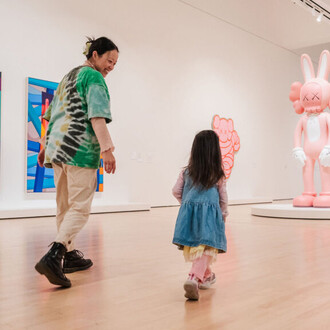Berggruen Gallery is pleased to present Straight Loops, an exhibition of recent paintings and works on paper by American artist Paul Kremer. This show marks Kremer’s third solo exhibition with the gallery.
In Straight Loops, Paul Kremer continues to stretch the bounds of organic form, working against strict definition in visual language or media, and towards a recognition of its inherent fluidity, especially in the abstracted form. This approach reveals the verisimilitude of visual identification between objects, thereby reconfiguring their symbolic and material relationships. Kremer’s process begins with shape rather than subject---this shape is conjured from his imagination, which is continually modeled, formed, and re-formed until Kremer is pleased with the final shape. Once setting the shape, Kremer continues applying and experimenting with color. It is only at the painting’s finish that Kremer titles his work, thus imposing a relation, and identity, onto the painted form.
An example of this occurs with the frilled white objects of Kremer’s “Mothers” series, which bear dual resemblance to a flower and an egg, allowing Kremer to underscore the maternal symbolism assigned to and shared across disparate lifeforms. In emphasizing these forms’ likeness, and identifying them as “mothers,” Kremer connects organic and graphic form with symbol, colliding maternity, biology, and geometry in a playful but poignant celebration of caregiving.
Of the relationship between geometric form and his artistic development as seen in Straight Loops, Kremer writes:
I wanted to take this opportunity to loop the new paintings in with variations of series from years past to bring it all together so people can see how I'm moving through space. I like seeing the old with the new, ideas that cycle, and with each cycle or loop, creating something new. I hope in this way, viewers can see the relationships in my work between curved and straight lines.
Kremer’s work is underlaid by a trademark wit characterized by experimentation with form and media, as well as a diverse appreciation of art history, design, and decorative art. In particular, Kremer’s admiration for Color Field and Hard Edge painters like Ellsworth Kelly, Ron Gorchov, and Morris Louis flows through not only his works’ geometric precision, but also his intensely vibrant color palettes, which recall the saturation of technicolor film. Kremer updates these masters’ formal explorations through his background as a graphic designer, effectively merging the fine and commercial arts.
In this vein, Kremer retains a spirited humor by incorporating inventive techniques that agitate painting’s mediatic boundaries. Kremer’s experimentation with modal convention often causes his paintings to acquire sculptural or mechanical qualities, or even invite curatorial collaboration. In Straight Loops, this approach manifested in rearrangeable “sets” which can be jigsawed into unique configurations. Still, the entirety of Kremer’s artistry is united by an admiration for two-dimensional linework and flattened geometry, wherein graphic shapes are compressed over canvas or paper and demarcated with crisp, sumptuous boundaries against the negative space. While their vivacity is visually attractive, the paintings’ flatness also creates a conceptual boundary between image and object, underscoring Kremer’s subversion of visual representation. As such, even though the artworks are flat, they acquire visual, historical, and intellectual dynamisms, working across technical and philosophical artistic approaches.
A self-taught artist, Paul Kremer was born in Chicago, Illinois in 1971, and lives and works in Houston, Texas. Before becoming a full-time artist, he owned a graphic design studio for twenty years, where he worked with clients such as Lou Reed, Tom Waits, MTV, PBS, and National Geographic. He was also a founding member of Houston-based art collective I Love You Baby, active from 1998 to 2008. Recent solo exhibitions include SPRING at Library Street Collective, Detroit; Life at Studio Cromie, Grottaglie, Italy; and Sets at Alexander Berggruen Gallery, New York.
















